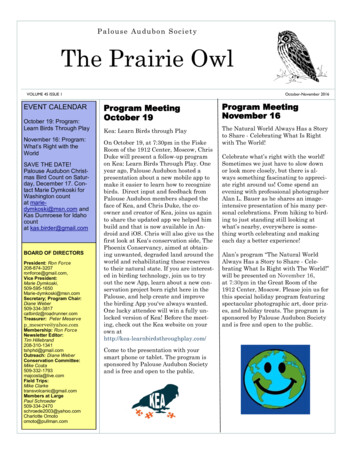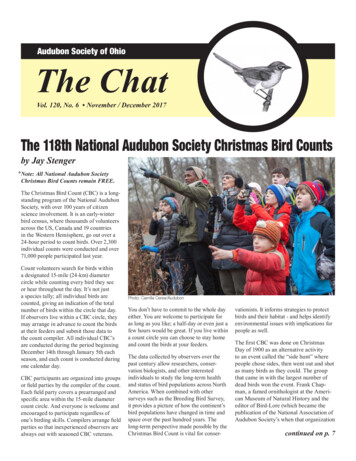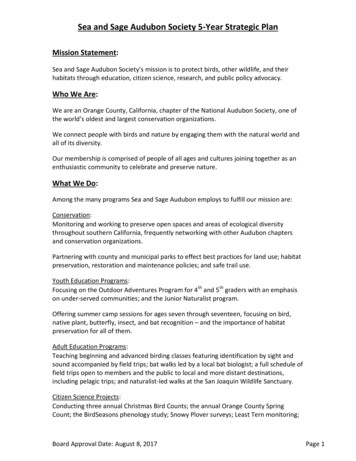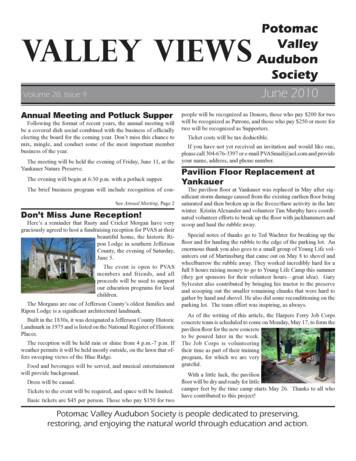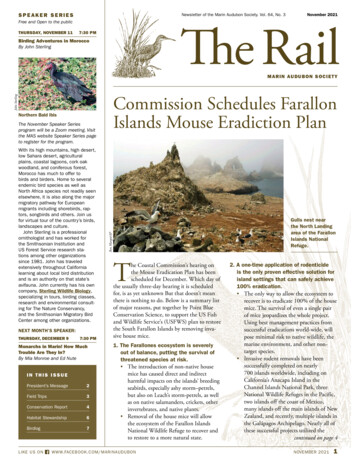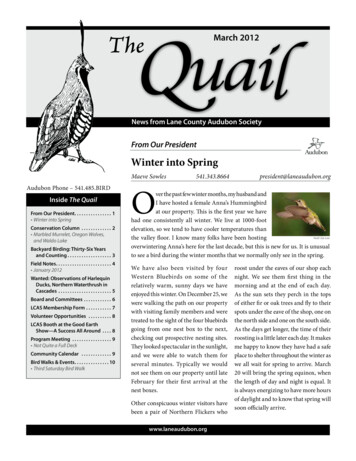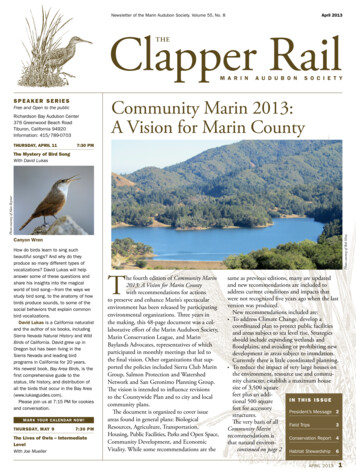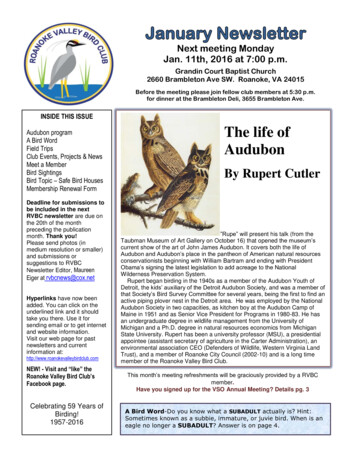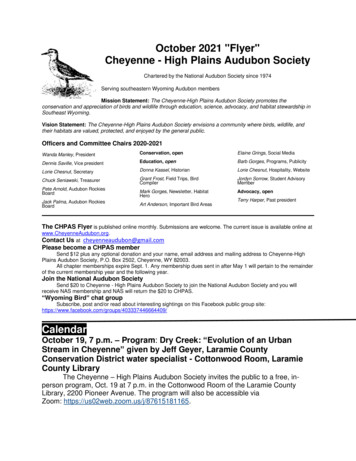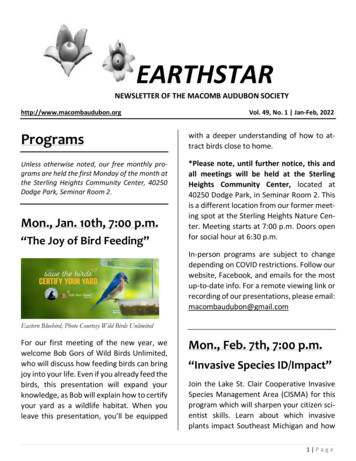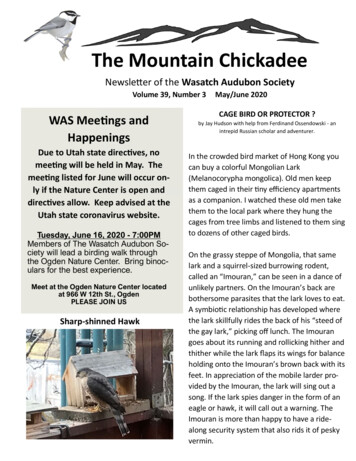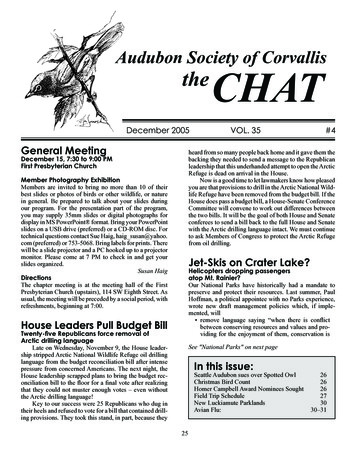
Transcription
Audubon Society of CorvallistheDecember 2005General MeetingCHATVOL. 35#4heard from so many people back home and it gave them thebacking they needed to send a message to the Republicanleadership that this underhanded attempt to open the ArcticRefuge is dead on arrival in the House.Now is a good time to let lawmakers know how pleasedyou are that provisions to drill in the Arctic National Wildlife Refuge have been removed from the budget bill. If theHouse does pass a budget bill, a House-Senate ConferenceCommittee will convene to work out differences betweenthe two bills. It will be the goal of both House and Senateconferees to send a bill back to the full House and Senatewith the Arctic drilling language intact. We must continueto ask Members of Congress to protect the Arctic Refugefrom oil drilling.December 15, 7:30 to 9:00 PMFirst Presbyterian ChurchMember Photography ExhibitionMembers are invited to bring no more than 10 of theirbest slides or photos of birds or other wildlife, or naturein general. Be prepared to talk about your slides duringour program. For the presentation part of the program,you may supply 35mm slides or digital photographs fordisplay in MS PowerPoint format. Bring your PowerPointslides on a USB drive (preferred) or a CD-ROM disc. Fortechnical questions contact Sue Haig, haig susan@yahoo.com (preferred) or 753-5068. Bring labels for prints. Therewill be a slide projector and a PC hooked up to a projectormonitor. Please come at 7 PM to check in and get yourslides organized.Susan HaigDirectionsThe chapter meeting is at the meeting hall of the FirstPresbyterian Church (upstairs), 114 SW Eighth Street. Asusual, the meeting will be preceded by a social period, withrefreshments, beginning at 7:00.Jet-Skis on Crater Lake?Helicopters dropping passengersatop Mt. Rainier?Our National Parks have historically had a mandate topreserve and protect their resources. Last summer, PaulHoffman, a political appointee with no Parks experience,wrote new draft management policies which, if implemented, will remove language saying “when there is conflictbetween conserving resources and values and providing for the enjoyment of them, conservation isHouse Leaders Pull Budget BillTwenty-five Republicans force removal ofArctic drilling languageLate on Wednesday, November 9, the House leadership stripped Arctic National Wildlife Refuge oil drillinglanguage from the budget reconciliation bill after intensepressure from concerned Americans. The next night, theHouse leadership scrapped plans to bring the budget reconciliation bill to the floor for a final vote after realizingthat they could not muster enough votes – even withoutthe Arctic drilling language!Key to our success were 25 Republicans who dug intheir heels and refused to vote for a bill that contained drilling provisions. They took this stand, in part, because theySee "National Parks" on next pageIn this issue:Seattle Audubon sues over Spotted OwlChristmas Bird CountHomer Campbell Award Nominees SoughtField Trip ScheduleNew Luckiamute ParklandsAvian Flu:25262626273030–31
National Parkscontinued from front pageto predominate.” ease the way for increased air and noise pollution andincreased high-impact uses previously barred frommost national parks, such as jet skiing, snowmobiling, and livestock grazing. dismantle protections for existing and potentialwilderness.There was an outcry when this news first leaked out lastsummer, and Mr. Hoffman’s draft was supposedly withdrawn. But then in October, the Park Service published itsproposed management policy, and it contained most of thesame elements as Mr. Hoffman’s draft! The Park Serviceis inviting comment on its proposed policies, so it’s up tous to tell them how bad the changes are.What can you do? The best thing is to read this website of the National Parks Conservation Association:www.audubon.org. For Oregon and Washington dates, seehome.pacifier.com/ patterson/cbc. If you are interestedin participating or would like further information, pleasecontact me at 752-4313 or mccarmel@peak.org.Corvallis CBC PotluckAfter the Corvallis Christmas Bird Count on Tuesday,December 20th, please come to the CBC Potluck at theEducation Hall of the First Presbyterian Church at 8th andMonroe. The potluck will run between 5 p.m. and 7 p.m.and includes a countdown of the birds seen during the count.Hot chili and drinks will be provided, and participants areasked to bring a side dish or dessert along with their ownplace setting (plate, bowl, silverware, cup). Feeder countersand family members of participants (including children)are welcome to attend.Marcia F. CutlerThe Great Backyard Bird tDetail.aspx?nid 1In addition to the CBC, please participate in the GreatBackyard Bird Count, which takes place from February17 to 20, 2006. Dave Eshbaugh, Executive Director ofOregon Audubon says, “While the Great Backyard BirdCount looks at birds toward the end of the winter season,the CBC provides a snapshot in the early winter.” The GreatBackyard Bird Count is jointly sponsored by the NationalAudubon Society, the Cornell Laboratory of Ornithology,Wild Birds Unlimited, and the National Science Foundation. Information about how you can participate is availableon the Web at http://www.birdsource.org/gbbc/Chris MathewsIt has details about how to comment, including a listof “talking points” for your letter. You can also submitcomments directly to NPS; mail them toBernard Fagan, Room 7252National Park ServiceOffice of Policy1849 C Street, NWWashington, D.C. 20240Dave MellingerIn this issue:Homer Campbell AwardNominees SoughtSeattle Audubon Sues ForRecovery PlanASC established the Homer Campbell Award in 2004 torecognize local achievements in conservation and to honorthe memory of Homer Campbell, a former ASC leader anda giant among Oregon conservationists. The first HomerCampbell Award was conferred in Spring 2005 upon ElzyEltzroth.Nominations for the 2006 awardee are invited fromCorvallis Auduboners and from the local conservation community. To nominate someone, send a letter or e-mail toDespite 1990 ESA Listing, Federal AgenciesHave Never Completed A Final Recovery PlanSeattle Audubon and Kittitas Audubon have filed a lawsuitto protect Washington’s Northern Spotted Owls. This action comes only after numerous rebuffed attempts to workwith our Federal Government agencies. This is still an earlystep. Please help us recognize the hard work of all those atSeattle Audubon, in particular, Alex Morgan, conservationdirector at Seattle Audubon, and Marina Skumanich, VicePresident of the executive Board.Christopher K. MathewsPresident, Audubon Society of Corvallis3336 SW Willamette Ave.Corvallis, OR 97333or to mathewsc2@comcast.netChristmas Bird CountTuesday, December 20thJoin us on Tuesday, December 20th, for the Corvallis Christmas Bird Count. For CBC dates around the nation, go toEach nomination letter should give brief biographi26
cal information about the nominee and should describe insome detail the contribution or contributions for which thisrecognition is being recommended. Additional supportingletters are welcome, but not required. One thoughtful anddetailed nomination letter is often more informative thanten perfunctory letters of endorsement.Nominations should be submitted before January 31,2006. A selection committee consisting of three ASC Boardmembers will consider the nominations, and the award willbe presented at a spring chapter meeting.Chris MathewsPresident, Audubon Society of CorvallisMay 18-21Malheur NWRSign-up sheets and trip information will be availableat the general meetings, or contact Paula Vanderheul atvanderp@peak.org 541-752-0470Paula VanderheulAudubon OregonEstablishes Its First New Chapter in 22 YearsThe Audubon Society of Lincoln City (ASLC), the first newAudubon chapter in Oregon in twenty-two years, held itskickoff event on November 5. The event was attended by100 people, and included presentations about the Chapter’sleaders and plans, Audubon’s centennial, and Pacific Northwest shorebird conservation.“Underlying all of this is a wonderful sense of excitement and potential in and about the Chapter,” said DaveEshbaugh, Executive Director of Audubon Oregon, whoassisted with the Chapter’s formation.The ASLC’s Board Members includes the Mayor ofLincoln City, the CEO of the local community college, theprincipal of one of the local elementary schools, and thechair of the Lincoln City planning commission. KathleenNickerson, who has over 15 years of volunteer and staffmanagement experience, is the Chapter President.For more information about the ASLC, go s/news25.txt.Field Trip ScheduleDec 10Dec 20Jan 14Feb 11Feb 18Saturday local morning birding 7:30 AMCorvallis Christmas Bird Count -- contactMarcia CutlerSaturday local morning birding 7:30 AMSaturday local morning birding 7:30 AMFull day birding: Fern Hill Wetlands andJackson Bottom -Forest Grove/HillsboroSecond SaturdaysOur second Saturday morning local field trip meets at theAvery Park Rose Garden parking area at 7:30 AM. Thisfield trip is especially interesting for beginner birders andnew birders to Oregon’s mid-valley area. We spend a lot oftime identifying local birds by sight and song. We visit thevalley National Wildlife Refuges-Finley, Baskett Slough,and Ankeny, as well as other birding areas throughout theyear. Field trip leader is Paula Vanderheul 541-752-0470,vanderp@peak.orgCall for Chat ContributionsPlease Share Your Stories, Photos, Thoughts,and Discoveries!What do you want to see in your ASC Chat? It all dependson you! All the items in the newsletter are written or suggested by ASC members. If you enjoy the Chat, that’s great– but it could be even better with your help. The ASC Chatneeds your help to fill each issue with interesting news ofwhat is flying, swimming, or hopping in the WillametteValley. Send your photos, stories, poems, and any othersuggestions to the Chat editors:Joan Newhouse and Neil Lidstromjoanelaine@cmug.com2035 SE Stone StreetCorvallis, OR 97333754-3120Full Day BirdingOn the full day trips we carpool, sharing gas cost withthe drivers. Everyone is to bring a large lunch, drinks,binoculars, spotting scope, warm clothing, sturdy shoes,and rain gear. We meet at 7:30 AM at the Benton Centerparking lot at 757 NW Polk. It can reached by turning easton Polk at the corner of Polk and 9th Street where BordersBooks is located.On Feb 18, 2006 I will lead a birding trip to FernHill Wetlands and Jackson Bottom Wetlands. It will bea day of walking diked ponds hopefully full of waterfowl. Be ready for rainy weather. Bring lunch, warmclothing, and your boots. We meet at the Benton Centerparking lot at 7:30 AM to carpool. We should returnby 6:00 PM. Contact Paula Vanderheul for questions:vanderp@peak.org 541-752-0470Spring Weekend BirdingMarch 17-19 Bandon CoastApril 21-23Klamath BasinMay 5-7 Rogue Valley, with Shakespeare play “UP”27
FieldNotesOctober 25 through November 22, 2005On 28 Oct Richard Hoyer watched a male Cooper’s Hawk buzza larger accipiter that was perched near his place in NW Corvallis; thelarger bird turned out to be an adult Northern Goshawk, a rare birdto see in town. A Red-shouldered Hawk was at McFadden Marsh 9Nov (Steve Seibel).With this year’s spike in vole populations, many observers havenoticed concentrations of Red-tailed Hawks in perennial grass fieldsaround the mid-valley. The hawks’ main hunting strategy seems to be“standing on the ground and just . waiting for the next vole to move,”Bob Altman noted 12 Nov.A more unusual choice of prey by a female Red-tailed Hawk ledto a remarkable chain of encounters which Richard Hoyer and ReedDemarest witnessed along Llewellyn Rd. 15 Oct. A female PeregrineFalcon parasitized the hawk by forcing her to release her catch, as thefalcon snatched it out of air. The hawk gave chase and amazingly wasable to keep up with the falcon. After a second Red-tailed Hawk joinedthe picture, the chase continued until one of the red-tails finally forcedthe falcon to release her ill-gotten gain, and made off with it.Investigating an object which had floated down to the road surfaceduring this chase, Richard and Reed found a three feathers from a maleAmerican Kestrel, stuck to a large piece of leaf-like lichen of a typewhich grows on the ground. They deduced that the first Red-tailed Hawkmust have blind-sided a kestrel that was on the ground.Rough-legged Hawks were seen in the Llewellyn Rd. areafrom 1 Nov onward. On 9 Nov three light morphs were in the fieldn. of Llewellyn Rd., and a dark morph was over McFadden Marsh (SSeibel).On 22 Nov Wil Geier and I saw an immature Golden Eagle alongLlewellyn Rd. The same day, Randy Moore saw a Golden Eagle in w.Linn Co., as well as a Rough-legged Hawk, 30 Red-tailed Hawks,six Northern Harriers, numerous American Kestrels and three PrairieFalcons – just about all in the space of two fields!A Merlin of the columbarius subspecies (less often seen herethan ssp. suckleyi) was at Stewart Lake 1 Nov (J Simmons). PeregrineFalcons were reported from McFadden Marsh 9 Nov (S Seibel), andtwice at Philomath STP 13 & 17 Nov (J Fontaine; M Cutler, R & NArmstrong). A Prairie Falcon was along Davis Rd. 6-12 Nov (J Harding;B Altman). Another was near Peoria 13 Nov (Roy Gerig).The American Coot flock at Philomath STP reached a count of250 by 30 Oct (J Fontaine). Quite a few were also at Stewart Lake 14Nov (Andrea Foster).Eight Greater Yellowlegs and 25 Long-billed Dowitchers wereat the E. E. Wilson canal pond 30 Oct. Two Least Sandpipers joined asmall flock of Western Sandpipers and American Pipits along McLagan Rd. in Linn Co. 12 Nov (B Altman). A Red-necked Phalarope wasat Philomath STP 6 Nov (Karl Fairchild, Jessie Leach; J Fontaine).A Bonaparte’s Gull briefly visited Philomath STP 6 Nov (KFairchild, J Leach). Two clean adult Western Gulls were there 1 Nov(N Strycker); although this can be the most common species at the coast,it is surprisingly rare in the valley.Other, more regularly occurring gull species showed up in numbersthis month, starting with a juvenile Glaucous-winged Gull at PhilomathSTP 30 Oct (J Fontaine). 15 California Gulls flew over our place ontheir way to Coffin Butte landfill 31 Oct, where more of their kind werejoined on 2 Nov by at least two Glaucous-winged Gulls and two Herring Gulls R Armstrong).Bill Proebsting saw a Barn Owl along the Campus Way bike pathnear the OSU swine facility 27 Oct. Two were in the barn near Finleyheadquarters 31 Oct R & N Armstrong). The approach of mating seasonfor Great Horned Owls was evident from one hooting at dawn nearWoodland Meadows Park in Corvallis, from late Oct onward (DaveMellinger).A Northern Pygmy-Owl was on Mary’s Peak 30 Oct (George& Cindy Grier). On 2 Nov I watched one that was actively huntingby the upper parking lot, and another perched silently closer to theThe weather this month was mostly typical for the season, withrainy weather alternating with colder, foggy mornings which sometimescleared off to fine sunny days. The first frost at our place near E.E.Wilson was a hard freeze 21 Nov, with temperatures down to 26o F asthe period ended colder than average.Two ASC field trips to Linn Co. and Lane Co. 12 & 19 Nov wereled by Paula Vanderheul, with several participants contributing reports.A Salem Audubon Society (SAS) field trip to Mary’s Peak 9 Nov wasled by Carol Karlen.One of the most celebrated Willamette Valley birds in previouswinters, a Falcated Duck, returned to the pond of an RV park near Coburg18 Nov (Peter Petricelli). This species is native to Asia. Participants inthe ASC field trip 19 Nov enjoyed this colorful bird, which has nowreturned four winters in a row according to the RV park owner.Abbreviations & Locations: NWR National Wildlife Refuge;STP sewage treatment pond(s). Baskett Slough (NWR) is near Dallasin Polk Co. Coffin Butte and E.E. Wilson (Wildlife Area) are north ofCorvallis along Hwy 99W. McFadden Marsh is at Finley (NWR) southof Corvallis. Middle Ridge is s. of Lebanon. Snag Boat Bend in LinnCo. near Peoria is an annex of Finley NWR.Inland ReportsLarge wintering flocks of Canada Geese and Cackling Geesearrived at valley refuges early in the period. A Snow Goose was withone such flock at Baskett Slough 18 Nov (Tom Love). Tundra Swansalso began to arrive, with five near Peoria 10 Nov (Mark Nikas) andnumbers increasing thru late Nov at Finley and Baskett Slough.A Eurasian Wigeon was with American Wigeons at BaskettSlough 13 Nov (Erik Knight). Well over a thousand Mallards gatheredat McFadden Marsh by 4 Nov; and many Green-winged Teal joinedthem by the end of the period. The count of Northern Shovelers atPhilomath STP reached 450 by 13 Nov (Joe Fontaine). Northern Pintailwere in the Peoria area 12 Nov (ASC field trip).The ASC field trip to Linn Co. 12 Nov found 15 Canvasbacks (PVanderheul). Two male Redheads showed up on Stewart Lake 31 Oct,the first there since 1993 (Jamie Simmons).Twelve Greater Scaup were at Philomath STP 30 Oct (J Fontaine).Lesser Scaup (our more common scaup species in the valley) andRing-necked Ducks were reported from many locations, along withBuffleheads, Common Mergansers, and Hooded Mergansers. Oneof the more unusual diving ducks was a Surf Scoter at Philomath STP5 Nov, when it joined fifteen Ruddy Ducks (Noah Strycker).The SAS field trip saw two Ruffed Grouse and three MountainQuail along the road up Mary’s Peak 9 Nov. A Blue Grouse was beside the same road 19 Nov (N Strycker). Raylene Gordin came acrossover a dozen Blue Grouse which were in shrubs and small trees atopMiddle Ridge 7 Nov.Two Horned Grebes were at Philomath STP 1 Nov; one vocalizingwhich is a sound not often heard in the valley (N Strycker). Three to fourEared Grebes were there from 25 Oct thru 13 Nov (N Strycker; J Fontaine), with two remaining 17 Nov (Rich & Nanette Armstrong, MarciaCutler). A Western Grebe visited Philomath STP 25 Oct (N Strycker);three were on the Stahlbusch Island ponds 10 Nov (M Nikas).Numbers of Great Egrets around Finley NWR continued to grow,with ten at Cheadle Marsh 2 Nov and two at Inavale School 4 Nov, and23 in the area by 6 Nov (M Cutler). Two were just e. of Albany 12 Nov(Jeff Harding).A very late Turkey Vulture was at Stewart Lake 2 Nov (NeilLidstrom, Joan Newhouse). A few have been staying in the valley inrecent winters, so perhaps this will turn out to be one of those.A White-tailed Kite showed up in the s. part of E.E. Wilson inthe last week of Oct (fide Ray Fiori). Six were in Kings Valley 9 Nov(SAS field trip).28
summit. At least two Burrowing Owls were in the Peoria area by 10Nov (Randy Campbell). Randy Moore saw one on 22 Nov, and also asoaring Short-eared Owl.A climber on Three Fingered Jack in the Cascades reported apossible Black Swift there 29 Oct (Alisdair Turner); this is about twoweeks later than the record late date for this species, but this is one ofthe least well-understood species in our region.A female Anna’s Hummingbird visited a feeder on Middle Ridge28 Oct R Gordin. On 20 Nov one also showed up at Pat Waldron’s placee. of Scio. As of 14 Jan a pair at Andrea Foster’s place in nw. Corvalliswere chasing each other around the premises.On 15 Nov a Belted Kingfisher perched 10 ft. away from anAmerican Kestrel on a utility wire on Stolz Hill Rd (w. edge of Lebanon),an odd pair of birds to see together R Gordin).An Acorn Woodpecker visited our yard near E.E. Wilson 10 Nov,only the second time we have seen one in a year; perhaps it was youngbird prospecting for new territory. One was along Bell Plain Rd. inLinn Co. 12 Nov (B Altman). On 20 Nov Andrea Foster had an unusualRed-breasted Sapsucker show up in her nw Corvallis yard. From herdescription it sounds like an individual of the “southern” race (subspeciesdagetti), which can look quite different from our usual local birds.A Black Phoebe continued at the Monroe STP thru 14 Nov (J Fontaine; R Armstrong). A Say’s Phoebe was along Pugh Rd. in Linn Co.12 Nov (P Vanderheul; J Simmons, Hendrik Herlyn, Oscar Harper).A Loggerhead Shrike continued e. of Ward Butte thru 10 Nov(R Campbell). A young Northern Shrike was perched along BruceRd. just e. of McFadden Marsh 2 Nov. One also turned up at the MarysRiver Natural Area in sw Corvallis, 20 Nov onward (Kim Nelson, WillWright).Jim Fairchild heard the distinctive call of a Blue Jay while working near the USDA National Germplasm Laboratory on Peoria Rd. 7Nov; eventually he and a co-worker were able to see the bird throughbinoculars. This eastern vagrant was in the company of Western ScrubJays and Steller’s Jays. The Blue Jay was seen again 12 & 13 Nov (JSimmons; R Gerig).Seven Horned Larks were atop Marys Peak 9 Nov (SAS field trip).A few were along Seward Rd. near Peoria 12 Nov (B Altman).Paul Bradley and Lori Greenfield spotted an American Dipperswimming in the Alsea River 16 Nov, during the Inavale 7th & 8thgraders’ visit to the Salmon Watch program at Clemens Park.After hiking up the summit trail at Marys Peak 2 Nov, I returned tofind 12 Western Bluebirds perched on and around my car in the parkinglot; the flock stayed around the thru 17 Nov R Armstrong). A flock alsocontinued atop Middle Ridge thru 21 Nov R Gordin).Large flocks of American Pipits include 60 at Philomath STP 1Nov (N Strycker), 130 along Greenberry Rd. 4 Nov, and hundreds s.of Seward Rd. near Peoria 12 Nov (B Altman). There were no reportsof Cedar Waxwings this month as most left our area; the last I saw thisfall were four on Coffin Butte 24 Oct.A single Yellow-rumped Warbler was frequenting a ditch atMarys River Natural Area as of mid-Nov (Kim Nelson, Will Wright). Afew were also noted at Finley, Philomath STP, Willamette Park, and OakKnoll STP among other places. On 4 Nov I saw a flock of at least fourTownsend’s Warblers foraging high in cottonwoods near the Evaniteplant at Willamette Park. Two were regularly visiting Rich & NanetteArmstrong’s yard in nw Corvallis as of 11 Nov.The first Swamp Sparrow of the season turned up in Randy &Mary Campbell’s yard in Peoria 20 Nov. Precious few local birders canclaim this very sparse wintering species as a “yard bird.” For those ofus not so lucky to find one in the back yard, good places to look includeE.E. Wilson, Luckiamute Landing, and other soggy, grassy places (nativetufted hairgrass or “kack” patches of teasel, grass and blackberries) thatregularly host Lincoln’s Sparrows in good numbers.Four White-throated Sparrows turned up in the ne. part of E.E.Wilson 30 Oct, about a half mile n. of the angling pond. Another wasat Philomath STP 13 Nov (J Fontaine). Our more common winteringsparrow species (Song, Fox, Golden-crowned, and White-crownedSparrows) were all present in abundance thru the period.Mark Nikas found a Lapland Longspur with a large flock ofAmerican Pipits and Horned Larks near Creek & Smith Rds. se. ofPeoria 10 Nov. Mark notes that this is nearly an annual site for this species, although they are usually very difficult to relocate.On 2 Nov I encountered a single Snow Bunting atop Mary’s Peak,which appeared to be a first-winter bird. It spent most of its time foragingout of sight in grass below the summit. One was again found there 17-18Nov R & N Armstrong, M Cutler; N Strycker), perhaps the same birdalthough it must have been good at hiding in the meantime.On 12 Nov Bob Altman found an interesting mixed flock of European Starlings and blackbirds along Green Valley Rd. near Peoria.Along with the expected Brewer’s and Red-winged Blackbirds, theflock included at least three Brown-headed Cowbirds and a Yellowheaded Blackbird, both rare in late fall and winter.A Gray-crowned Rosy-Finch was reported atop Mary’s Peak 9Nov (SAS field trip). A male Cassin’s Finch “with a punk-red hairdo”stopped by Andrea Foster’s NW Corvallis feeder 13 Nov in the companyof House Finches. This species is usually found east of the Cascades,and most vagrants to Benton Co. have been on Marys Peak rather thanin town.Nanette Armstrong spotted a River Otter in the canal pond at E.E.Wilson in early Nov. A Giant Stonefly nymph was one of the highlightsfor Inavale 7th & 8th graders sampling insects from the Alsea River 16Nov, with the help of Salmon Watch volunteer Guy Allen.Coastal NotesWintering Black Brant flocks began to return to the central OregonCoast this month, with 18 passing Boiler Bay 25 Oct (Phil Pickering)and 17 on Yaquina Bay by 6 Nov (N Strycker).Two Eurasian Wigeons (male and female) were with about 600American Wigeons on Yaquina Bay 30 Oct (G & C Grier). 400 Northern Pintail and 40 Greater Scaup were there by 6 Nov (N Strycker).On 14 Nov a female eider (most likely to be a King Eider) flewpast Boiler Bay with a flock of scoters (P Pickering). Small numbers ofBlack Scoters passed there along with the usual large numbers of Surfand White-winged Scoters through the period (P Pickering). A BlackScoter and a Long-tailed Duck were between the jetties at YaquinaBay 6 Nov (N Strycker).400 Short-tailed Shearwaters off Boiler Bay 4 Nov were the firstlarge concentration of the season. 150 Brown Pelicans were there 6 Nov(P Pickering). A late Osprey was at Yaquina Bay 6 Nov (N Strycker).Seven Marbled Godwits were on the beach at Spanish Head 31Oct (P Pickering). Two Rock Sandpipers were with Surfbirds at DepoeBay 30 Oct (Floyd Schrock); this is one of the more reliable places tosee this species in our area.A Snow Bunting was along the nature trail at Hatfield MarineScience Center 29-30 Oct (Greg Gillson; G Grier). An unusual grosbeakvisiting Roy Filby’s feeder in Newport 3 Nov was determined to be mostlikely a hatch-year male Rose-breasted Grosbeak based on photos.Next monthPlease send your sightings by Dec 27th to:Joel Geier, 38566 Hwy 99W, Corvallis, OR 97330-9320(541) 745-5020 or jgeier@attglobal.net29
New Luckiamute Parklandsrestoring mid-1800s vegetation has already impacted theirhabitat. Further “restoration” in this direction could resultin greater losses, unless compensatory grassland habitatnearby is part of the plan.ASC members should also be aware that OPRD willface pressure from recreational users, and perhaps internalpressure to develop something more “park-like.” Yourcomments will be important to ensure that protection ofsensitive species and their habitat is a top priority.Send OPRD Your CommentsThe Oregon Parks and Recreation Department (OPRD) hasstarted work on a master plan for state park lands at theconfluence of the Luckiamute and Willamette Rivers. Thisland lies between Buena Vista Rd. and the Willamette justsouth of the community of Buena Vista. Through December 14, citizens can give OPRD comments on issues andpriorities for this plan, which will govern over 1000 acresof unique wildlife habitat for the next 20 years.The centerpiece of this plan is the Luckiamute Landinggreenway parcel. This holds one of the largest remnants ofthe bottomland deciduous forest that once lined the banksof the Willamette. The parcel hosts five species of woodpeckers, Red-eyed Vireo in some years, a small nestingpopulation of Oregon Vesper Sparrow, as well as severalnearby nesting pairs of Osprey and Bald Eagles, and anabundance of wintering sparrows and finches, usually attended by raptors such as Merlins, Sharp-shinned Hawks,and Cooper’s Hawks.A second greenway parcel, the Vanderpool Tract, includes bottomland habitat similar to Luckiamute Landing,but also mature oaks that regularly host a Western Bluebirdflock. OSU researchers have learned that the ponds containone of the mid-Willamette Valley’s largest populations ofWestern Pond Turtles, as well as Red-legged Frogs.Two smaller adjoining parcels are mainly agriculturallands on which OPRD plans to restore native habitats.An additional parcel managed by Oregon Dept. of Fish& Wildlife is not covered by OPRD’s master plan for thepark lands, but is also being restored and thus adds to thepotential of the project as wildlife habitat. Some of thisland could serve as nesting habitat for “Streaked” HornedLarks, a critically imperiled Willamette Valley subspecies.Up to 40 of these larks (a significant fraction of the totalpopulation), now nest on private farmland within two milesof the park lands.OPRD presented the initial stage of the planning process at a public meeting in Monmouth on November 14.Park facility ideas are so far mostly positive and modest:the boat-in campground will be relocated from an erodingbank to a spot just up-river. A proper vault restroom and anOPRD field office may be built at existing building sites.Some trails and fishing/hunting rules may be revised toreduce disturbance to pond turtles. OPRD intends to continue with bottomland restoration. Two local farmers whoattended the meeting were both supportive of the aims.OPRD seems to have good intentions for restoringthe historical, mid-1800s bottomland habitat. However,one concern is the role that these lands now play in theexisting, highly fragmented Willamette Valley ecosystem.Oregon Vesper Sparrows would not have nested in thehistoric, bottomland forest, but have come to depend onthe present-day openings. Tree-planting with the aim ofPlease send your comments on the future of these parklands by Dec. 14 to:Ron Campbell, Master Planning CoordinatorOregon Parks and Recreation Dept.725 Summer St., Suite C.Salem, OR 97301-1271or via e-mail at ron.campbell@state.or.us ,or by phone at (503) 986-0743.OPRD’s information on the planning process can befound on the Web at:http://egov.oregon.gov/OPRD/PLANS/planning luckiamute.shtmlFor more information about these lands and the birdsthat call them home, contact Joel Geier (contact info onthe back page of the Chat).Joel GeierAvian Flu:What It Could Mean for Wild Birds (and Birders)Avian flu and the fear of a deadly global epidemic has thepotential to radically alter public attitudes and interactionswith wild birds. It is already having a drastic effect on somewild bird populations.“Regular” Avian Flu and H5N1There are many different strains of avian flu – most causeonly mild disease
The Audubon Society of Lincoln City (ASLC), the first new Audubon chapter in Oregon in twenty-two years, held its kickoff event on November 5. The event was attended by 100 people, and included presentations about the Chapter’s leaders and plans, Audubon’s
